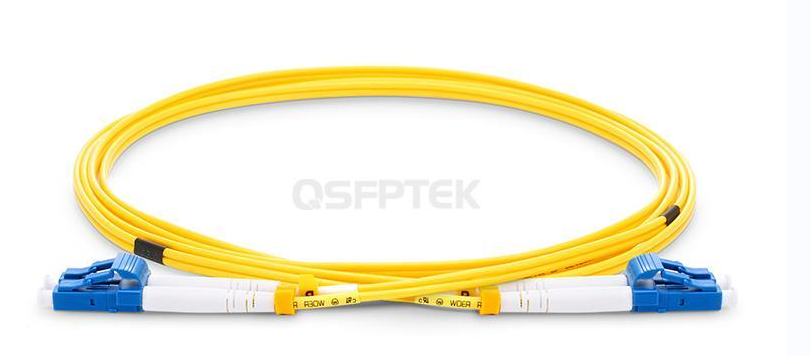Comprehensive Introduction of Single Mode Fiber G.652 VS G.655
The Singlemode fiber can be divided into two categories, the G.65x series and the IEC 60793-2-50, this post will only introduce the simpler ITU-T G.65x. Six different types of Singlemode fibers are defined in the ITU-T: G.652, G.653, G.654, G.655, G.656, and G.657. G.652 and G.655 are the two most widely used models. This post will introduce the differences between the G.652 vs G.655 to help you to choose the right SMF cable.

Figure 1: Singlemode Optical Fiber
What is Singlemode Fiber G.652?
G652 fiber is the most widely used single-mode fiber and the first edition was standardized in 1984. It can be divided into four subcategories: G.652.A, G.652.B, G.652.C, and G.652.D. The four versions are all used G652 core size, which is 8-10 micrometers. The performance of G.652.C and G.652.D fiber is higher than that of G.652.A and G.652.B.
Both the G.652.A and B are designed to have a zero dispersion wavelength point at 1310 nm, which makes them very suitable for operation in the 1310 nm band. However, due to the existence of water peaks nature, they are not suitable for use in wavelength division multiplexing (WDM). The enhanced versions of G.652.C and G.652.D eliminate the water peaks of spectral operation to achieve the best optimization effect, this makes them work effectively in the wavelength range of 1310 to 1550 nm, so that it can support coarse wavelength division multiplexing(CWDM). Compared with G.652.C, G.652.D single-mode fiber has superior PDM (polarization mode dispersion) parameters. Therefore, G.652.D is called standard single-mode fiber (SSMF) and is usually used in building 10GbE and 40GbE networks. Click here for more information about Single-mode fiber. The following table shows the different categories of the G.652 series in detail.
| Wavelength | Maximum Attenuation Rate | Application | |
| G.652.A | 1310nm-1550nm | 1310nm: 0.5dB/km 1550nm:0.4dB/km | Deployed in 10G, 40G Ethernet, 10G up to 40km |
| G.652.B | 1310nm-1625nm | 1310nm: 0.4dB/km 1550nm: 0.35dB/km 1625nm: 0.4dB/km | Some higher bit rate applications like 10G |
| G.652.C | 1310nm-1625nm | 1310nm to 1625nm: 0.4dB/km 1383 nm ± 3 nm: 0.4dB/km 1550nm: 0.3dB/km | Similar to G.652.A. Transmission bands extended to 1360nm to 1530nm and 1560nm to 1625nm. Suitable for CWDM systems |
| G.652.D | 1310nm-1625nm | 1310nm to1625nm: 0.4dB/km 1383nm± 3nm:0.4dB/km 1530-1565nm: 0.3dB/km | Similar to G.652.B. Transmission bands extended to 1360nm to 1530nm. Suitable for CWDM systems |
What is Singlemode Fiber G.655?
G.655 Singlemode fiber can be divided into five types: G.655.A, G.655.B, G.655.C, G.655.D, G.655.E, and the variants C&D&E are the most widely used types. Because the dispersion of G.655 single-mode fiber approach zero but is not equal to zero at 1550nm wavelength, it is called Non Zero Dispersion-shifted Fiber (NZDSF). NZDSF can be divided into two types, (-D) NZDSF stands for a negative slope versus wavelength, and (+D) NZDSF refers to a positive slope versus wavelength.
The chromatic dispersion of G.655 single-mode fiber in the C-band (1530nm - 1565nm) will become lower, and the function of the optical amplifiers will be utilized to the greatest extent in C-band. Meanwhile, the core area of G.655 fiber is larger than G.652 fiber. The enhanced dispersion-shifted fiber makes G.655 balance four-wave mixing and other nonlinear effects. G.655 single-mode fiber supporting longer transmit distance and larger capacity can satisfy the requirements of dense wavelength division multiplexing (DWDM) transmission.

Figure 2: Dispersion Difference Between G.652 and G.655
The following table shows the commonly used categories of the G.655 series in detail:
| Wavelength | Maximum Attenuation Rate | Application | |
| G.655.C | 1550-1625nm | 1550nm: 0.35dB/km 1625nm: 0.4dB/km | (1). Recommendations such as G.691, G.959.1, and G.693. (2). The channel spacing defined in G.694.1 is supported in DWDM systems, depending on the selected minimum chromatic dispersion. |
| G.655.D | 1550-1625nm | 1550nm: 0.35dB/km 1625nm: 0.4dB/km | For wavelengths more than 1530 nm, the applications same as G.655.C. While the wavelengths less than 1530 nm, support CWDM applications at channels from 1471nm and higher. |
| G.655.E | 1550-1625nm | 1550nm: 0.35dB/km 1625nm: 0.4dB/km | Same as G.655.D, but the small channel spacings give more value to it. |
G652 VS G655 SMF Cables: Which to Choose?
The G.652 SMF fiber is usually applied to LAN, MAN, access layer, designed for the cost-efficient CWDM system. In these applications mentioned above, signal amplification is not required because they are transmitted over a short distance. The G.655 is designed for long-distance transmission and DWDM, its main advantage is the perfect performance in low dispersion (including dispersion and polarization mode dispersion).
The different demands lead to different choices. G.652 and its enhanced version G.657 are cost-efficient, standard single-mode fiber for 10Gbps Ethernet with a short distance. If you need to build a higher bandwidth Ethernet network of more than 10Gbps or support long-distance transmission with higher performance, the more expensive G.655 SMF cable will be better.
Conclusion
This article introduces two kinds of single-mode fiber in detail: G.652 vs G.655. When you don't have a high demand for transmission rate and transmission distance, you can choose G.652 fiber for your data center. When you need to use the DWDM system, you can select G.655 fiber which provides higher data capacity and longer transmission distance. As for price, the G.655 optical fiber solution will cost more. QSFPTEK provides various optical fibers, if you still have any questions about Singlemode fiber, contact [email protected].










